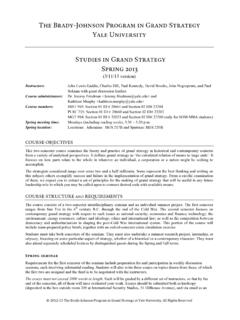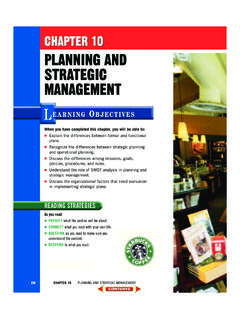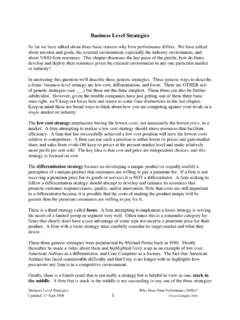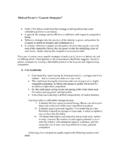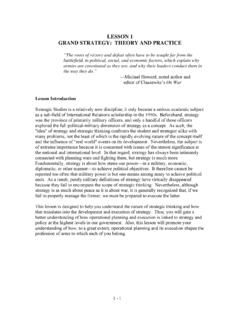Transcription of Twenty-Five Examples of - Sterling & Selesnick
1 Twenty-Five Examples of Organizational grand strategies Hinda K. Sterling Herbert L. Selesnick & Sterling Selesnick , INC Twenty-Five Examples of Organizational grand strategies grand strategies are comprehensive general approaches that are viewed by the organization as necessary to the accomplishment of its mission and the achievement of its preferred future. grand strategies may be short-term focused organizational efforts or long-term far-reaching initiatives. An organization should review and consider a variety of widely used grand strategies before deciding how to position itself to operate successfully in its particular environment. grand strategies to be considered should include but not necessarily be limited to some or all of the following: 1.
2 General Growth--increasing the size of the organization to realize economies of scale, enlarge the organization's marketplace, build operating surpluses or for some other expansion related reason. 2. Concentrated Growth--choosing to focus on and upgrade or increase the market penetration of a limited number of successful products or services that have been mainstays of the organization. 3. Compensating Diversification--choosing to acquire or merge with another entity that counterbalances the organization's own strengths and weaknesses. 4. Concentric Diversification--choosing to acquire or merge with other organizations that are compatible with or reinforce the organization's technology, markets, products or services. 5. Product/Service Diversification--choosing to move into new areas of focus or spheres of activity to utilize the organization's existing resources, as the organization's primary markets mature or decline.
3 6. Geographic Dispersion--choosing to create multiple field units in the same area of focus or sphere of activity but in different geographic locations. 7. Expansion of Volume--choosing to increase revenues from a single new source or market or from existing sources or markets. 8. Integration--choosing to consolidate major systems or processes, usually through mergers or acquisitions. 9. Horizontal Integration--choosing to acquire or merge with a similar organization in order to reduce competition. 10. Vertical Integration--choosing to develop an internal supply network that puts the organization closer to its producers or providers (backward integration), or to develop an internal distribution system that puts the organization closer to its end users (forward integration).
4 11. Quality Improvement--choosing to improve the organization's status, capacity, resources and influence by continuously upgrading its existing products, services and internal operating capabilities. 12. Market Development--choosing to add new customers in related markets. Twenty-Five Examples of Organizational grand strategies 13. Product/Service Development--choosing to create new, but related products or services that can be sold to the organization's existing primary markets. 14. Piggybacking--choosing to offset declining revenue or income in one or more areas of focus or spheres of activity, or to subsidize one or more particularly desirable spheres of activity, with income earned in other sphere(s) of activity. 15. Focus/Specialization--choosing to limit and focus the organization's activities, often by withdrawing from certain areas of focus or spheres of activity, so that it only does what it can do well within a particular arena or niche, typically by aiming at a particular customer group, segment of the product or service line, or geographic market.
5 16 Innovation/Differentiation Leadership--choosing to create products or services that are perceived in the marketplace to be so new, so different or so superior (often by applying cutting-edge information technology) that they expand performance boundaries and make existing products or services obsolete. 17. Operational Excellence--choosing cost-and-convenience leadership by attempting to produce the lowest cost and most readily accessible products or services, often through an emphasis on strategic or competitive sourcing. 18. Customer Intimacy--choosing through the cultivation of relationships to develop and maintain unparalleled knowledge and understanding of the current, emerging and prospective needs of the clients, customers, industries or markets served by the organization.
6 19. Strategic Alliance--choosing to develop teams, partnerships, joint ventures, networking, shared services or cooperative programs with suppliers, customers or other compatible enterprises, in order to develop new products, markets, services or efficiencies. 20. Financial Independence--striving for diversification of the organization's funding sources as a way of gaining control over its fiscal environment. 21. Legal Independence--striving to avoid or end being owned or constrained by, or being part of, another organization in order to achieve, increase or preserve operating autonomy, freedom of action and visibility. 22. Retrenchment--choosing to turn around or reverse the negative trends in operating surpluses, primarily through a variety of cost-cutting methods.
7 23. Downsizing--choosing to reduce the scope or scale of products and services to fit financial or other constraints. 24. Divestiture--choosing to sell off or close down a segment of the organization. 25. Liquidation--choosing to go out of business if the organization is no longer viable or if its mission has been fulfilled, usually by selling off the organization for its tangible assets and closing it down
